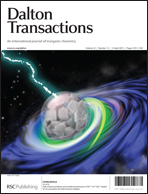The Cu(i) catalyzed Meerwein reaction in aqueous solutions proceeds via a radical mechanism. The effect of several ligands
Abstract
The effect of the ligands 2,5,8,11-tetramethyl-2,5,8,11-tetraaza-dodecane and fumarate on the mechanism and kinetics of the Cu(I) catalyzed Meerwein reaction was studied. The results point out that initially the Cu(I) ion binds to the aromatic ring with the diazo substituent. This reaction is followed by a redox process involving N2 loss and the formation of an aryl radical, R˙. The following kinetics depends on the nature of the ligand, its effect on the redox potential and the steric hindrance it induces on the central copper ion. Clearly the ligand 2,5,8,11-tetramethyl-2,5,8,11-tetraaza-dodecane does not form an optimal catalyst with Cu(I) while it does for the Ullmann reaction.


 Please wait while we load your content...
Please wait while we load your content...